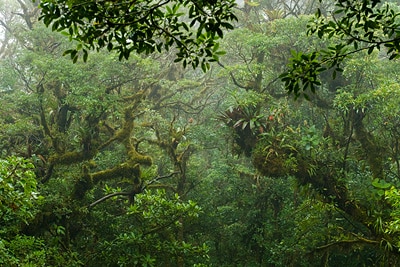How Trees Shape Our Climate
One role that trees play in the complex dance of Earth’s climate that is sometimes disregarded but is unquestionably important is cloud production. These enormous giants of the plant kingdom have a subtle but significant impact on the basic structure of our atmosphere, a fact that is sometimes overlooked in favour of their more obvious effects on biodiversity and air quality.
Silent cloud builders, trees emit a symphony of fragrant chemicals called volatile organic compounds (VOCs) that mix with the surrounding air. Like tiny emissaries, these VOCs set off on an invisible voyage, interacting with other elements of the atmosphere to generate aerosols, which are minuscule particles. As condensation nuclei, these aerosols give water vapour a place to change from a thin gas into liquid droplets, which are the fundamental components of clouds.
Table of Contents

Every species of tree releases a different kind of volatile organic compound (VOC), which gives the air its own distinct scent. Conifers emit a waterfall of terpenes from their evergreen needles, and deciduous trees release a lot of isoprene from their colourful foliage. Environmental conductors like sunshine and temperature also play a role in the strength of this VOC symphony, resulting in a dynamic ballet of chemical exchange.
Tree-produced volatile organic compounds (VOCs) are essential for the production of clouds, but their effects go beyond this invisible dance. Trees release water vapour during transpiration, which is another crucial component in the production of clouds. As leaves receive energy from sunlight, they release molecules of water into the atmosphere, which contributes to the imperceptible store of humidity that clouds absorb.
But there is more to trees’ influence on cloud formation than meets the eye. Their imposing presence has the ability to both literally and symbolically cast a shadow. Trees can limit the amount of water vapour available for cloud formation by preventing excessive evaporation by obstructing sunlight from reaching the ground. The complex function that trees play in influencing our climate is shown by the dance of light and shadow, as well as the careful balance between cloud creation and suppression.
Trees have a significant cumulative impact on the production of clouds. Research has indicated that forests, with their thick stands of trees, can raise cloud cover by up to 10%, especially in areas that are covered in these lush stretches of greenery. By reflecting sunlight back into space, this increase in cloud cover acts as a cosmic shield, reducing the amount of heat trapped by greenhouse gases and causing the earth to cool.
The function of trees in creating clouds has become more important due to climate change. The potential of trees to affect cloud formation is becoming less and less viable due to the combined challenges of deforestation and climate change. Preserving this natural climate regulator requires increasing tree cover and safeguarding existing forests.
As unsung heroes, trees are the quiet titans of our world, influencing our climate both physically and through their intangible emissions. We can better appreciate their varied effects on our surroundings when we comprehend their complex involvement in cloud formation. Let us not underestimate the power of trees, our planet’s cloud creators, in our efforts to slow down climate change.
In the fight against climate change, trees fight silently but are essential to maintaining the planet’s temperature, water cycle, and even air quality. These leafy heroes protect Earth’s climate in the following ways:
Carbon Capture Champions (How Trees Shape Our Climate):
How Trees Shape Our Climate: Trees eat carbon dioxide, the villain of climate change, much like superheroes eat villains. They store carbon in their roots, trunks, and leaves and convert CO2 into oxygen, which is necessary for life. This process, called sequestration of carbon, serves as an organic temperature brake. Think of forests as a huge network of air purifiers that remove greenhouse gases from the atmosphere.
Water Cycle Wizards:
How Trees Shape Our Climate: Trees are adept at controlling the flow of water. Their complex root systems function as natural sponges, collecting rainfall, stopping erosion, and controlling the amount of water that enters rivers and streams. Trees protect against floods and droughts by slowing down and storing water, which guarantees a more consistent flow of this valuable resource even in the face of shifting weather patterns. Consider them as little dams controlling the water supply on Earth.
Sun Shade Experts:
How Trees Shape Our Climate: Trees serve as Earth’s natural umbrellas and are much more than simply attractive green décor. Their leaves serve as a means of reflecting sunlight back into space, which aids in controlling the planet’s temperature. In tropical regions, where deforestation can transform verdant landscapes into sun-baked deserts, the albedo effect is particularly significant. Consider trees as millions of tiny sunshades that provide comfortable cooling conditions for our planet.
Wind Whisperers (How Trees Shape Our Climate):
How Trees Shape Our Climate: Communities are protected from damaging gusts and storms by forests, which serve as windbreaks. They shield delicate landscapes from soil erosion by absorbing wind energy through their leaves and branches. Consider them as living walls that provide protection from the unpredictable weather and wind.
Biodiversity Builders (How Trees Shape Our Climate):
How Trees Shape Our Climate: Trees are vital to the health of the planet and are not just climate heroes. For innumerable species, from tiny insects to regal birds and mammals, they serve as essential habitat. The survival of innumerable species and the upkeep of healthy ecosystems depend on this biodiversity. Think of forests as vibrant metropolises that are brimming with life in all of its forms.
Sadly, people frequently ignore or take these leafy heroes for granted. These essential climate functions are disrupted by deforestation, making the earth more susceptible to the effects of climate change. It is our duty to acknowledge the important role that trees play and work to preserve and revitalise their communities. We guarantee a better, colder, and more colourful future for ourselves and all other living things by appreciating and protecting our forests.
Recall that trees are more than just sources of wood; they are vital allies in the fight against global warming. Together, let’s keep them erect and strong so that future generations can benefit from a better climate.
I hope this gives you a thorough understanding of how trees affect our climate. If you would like to go deeper into any of these points or have any more questions about particulars, please don’t hesitate to ask!


